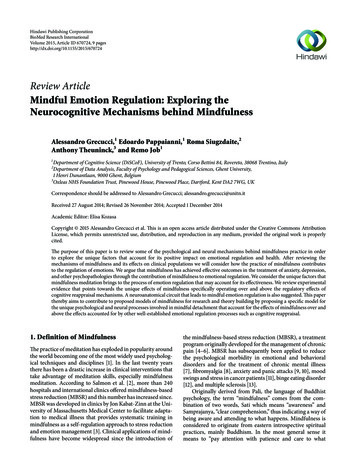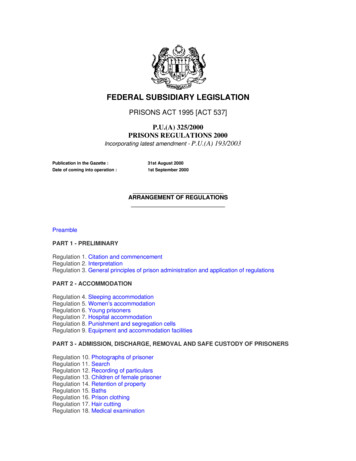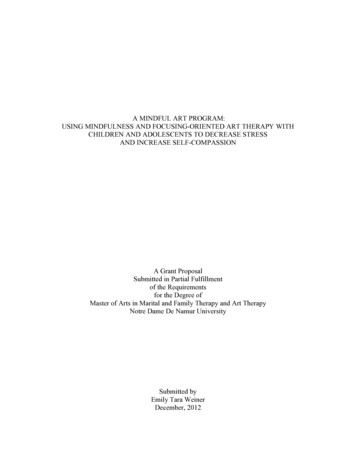
Transcription
Hindawi Publishing CorporationBioMed Research InternationalVolume 2015, Article ID 670724, 9 pageshttp://dx.doi.org/10.1155/2015/670724Review ArticleMindful Emotion Regulation: Exploring theNeurocognitive Mechanisms behind MindfulnessAlessandro Grecucci,1 Edoardo Pappaianni,1 Roma Siugzdaite,2Anthony Theuninck,3 and Remo Job11Department of Cognitive Science (DiSCoF), University of Trento, Corso Bettini 84, Rovereto, 38068 Trentino, ItalyDepartment of Data Analysis, Faculty of Psychology and Pedagogical Sciences, Ghent University,1 Henri Dunantlaan, 9000 Ghent, Belgium3Oxleas NHS Foundation Trust, Pinewood House, Pinewood Place, Dartford, Kent DA2 7WG, UK2Correspondence should be addressed to Alessandro Grecucci; alessandro.grecucci@unitn.itReceived 27 August 2014; Revised 26 November 2014; Accepted 1 December 2014Academic Editor: Elisa KozasaCopyright 2015 Alessandro Grecucci et al. This is an open access article distributed under the Creative Commons AttributionLicense, which permits unrestricted use, distribution, and reproduction in any medium, provided the original work is properlycited.The purpose of this paper is to review some of the psychological and neural mechanisms behind mindfulness practice in orderto explore the unique factors that account for its positive impact on emotional regulation and health. After reviewing themechanisms of mindfulness and its effects on clinical populations we will consider how the practice of mindfulness contributesto the regulation of emotions. We argue that mindfulness has achieved effective outcomes in the treatment of anxiety, depression,and other psychopathologies through the contribution of mindfulness to emotional regulation. We consider the unique factors thatmindfulness meditation brings to the process of emotion regulation that may account for its effectiveness. We review experimentalevidence that points towards the unique effects of mindfulness specifically operating over and above the regulatory effects ofcognitive reappraisal mechanisms. A neuroanatomical circuit that leads to mindful emotion regulation is also suggested. This paperthereby aims to contribute to proposed models of mindfulness for research and theory building by proposing a specific model forthe unique psychological and neural processes involved in mindful detachment that account for the effects of mindfulness over andabove the effects accounted for by other well-established emotional regulation processes such as cognitive reappraisal.1. Definition of MindfulnessThe practice of meditation has exploded in popularity aroundthe world becoming one of the most widely used psychological techniques and disciplines [1]. In the last twenty yearsthere has been a drastic increase in clinical interventions thattake advantage of meditation skills, especially mindfulnessmeditation. According to Salmon et al. [2], more than 240hospitals and international clinics offered mindfulness-basedstress reduction (MBSR) and this number has increased since.MBSR was developed in clinics by Jon Kabat-Zinn at the University of Massachusetts Medical Center to facilitate adaptation to medical illness that provides systematic training inmindfulness as a self-regulation approach to stress reductionand emotion management [3]. Clinical applications of mindfulness have become widespread since the introduction ofthe mindfulness-based stress reduction (MBSR), a treatmentprogram originally developed for the management of chronicpain [4–6]. MBSR has subsequently been applied to reducethe psychological morbidity in emotional and behavioraldisorders and for the treatment of chronic mental illness[7], fibromyalgia [8], anxiety and panic attacks [9, 10], moodswings and stress in cancer patients [11], binge eating disorder[12], and multiple sclerosis [13].Originally derived from Pali, the language of Buddhistpsychology, the term “mindfulness” comes from the combination of two words, Sati which means “awareness” andSamprajanya, “clear comprehension,” thus indicating a way ofbeing aware and attending to what happens. Mindfulness isconsidered to originate from eastern introspective spiritualpractices, mainly Buddhism. In the most general sense itmeans to “pay attention with patience and care to what
2BioMed Research Internationalhappens” [14, 15] and can be cultivated through meditation.However, you can find forms of mindfulness and meditationin almost all of the world’s religions, such as yogic meditationin the Hindu tradition, kabbalah meditation in Judaism,contemplative prayer in Christianity, and Sufi meditation inIslam [16].Adopted in western societies amongst enthusiasts of transcendental and metaphysical practices, mindfulness increasingly attracted scientific research to become recognized as aneffective psychological practice for stress, pain management,and mental health problems [17].Models of psychopathology recognize that automaticbehavior without conscious attention to behavior (mindlessness) is associated with intrusive and ruminative thoughtsabout past or future events, leading to distressed states ofmind, passivity, and the repetition of habitual coping patterns [18]. According to Kabat-Zinn, mindfulness meditationaddresses this state of mind by cultivating a state of mind thatis “on purpose” and “attentive” to reduce “mind wandering”(see [19] for the negative effects of mind wandering).Mindfulness has been defined as a “nonelaborative, nonjudgmental, present-centered awareness in which each thought,feeling, or sensation that arises in the attentional field isacknowledged and accepted as it is” [20]. Kabat-Zinn [21]proposed a list of attitudes and behaviors that help developbeing mindful in everyday life:(1) nonjudging: being an impartial witness to your ownexperiences without premature conclusions;(2) patience: letting things unfold in their own time;(3) beginner’s mind: being receptive to new possibilitiesand not getting stuck in a rut of your own expertise;(4) trust: developing a basic trust in yourself and yourfeelings;(5) not striving: paying attention to how you are rightnow however that is;(6) accepting: seeing things as they actually are in thepresent;(7) letting go: letting go is a way of letting things be, ofaccepting things as they are.Mindfulness-based stress reduction therapy is only one ofmany western adaptations of mindfulness practices appliedin clinical settings. While mindfulness practice takes manyforms, one common practice, especially in mindfulnessbased therapies, is mindfulness of the breath. In a typicalpractice instruction, Kabat-Zinn suggests that participantssit comfortably with eyes closed and direct their attentionto the physical sensations of breathing by simply noticingit, paying attention to it, and being aware of it. Whenthoughts, emotions, physical feelings, or external soundsoccur, practitioners are instructed to accept them and allowthe recognition of these stimuli to come and go withoutjudging or getting involved. When attention has drifted offand is becoming caught up in thoughts or feelings it isadvised that the practitioner notes this drift and gently bringsattention back to breathing.The defining psychological processes in mindfulnessmeditation are the unique attentional focus and attitudinalstance taken by the practitioner. The philosopher Husserldescribed the basic assumption of mindfulness as “payingattention to the experience as it presents itself without anyinterpretational filtering.”This first component of mindfulness requires awarenessand controlled effort to maintain full conscious focus in the“present moment” without wandering into thoughts of thepast or the future. Mindfulness meditation seeks to cultivatethis skill by first building awareness or “sustained attention”[22, 23], namely, the ability to maintain attentional focuson one object for a sustained period of time. Mindfulness traditionally focuses attention on the breath withoutrepressing the flow of thoughts, feelings, and sensationsthat may supervene on the attentional focus. With repeatedpractice meditators report a capacity to focus and sustaintheir attention whilst experiencing a decreased frequency ofdistractions or intrusions into their attentional field duringboth formal meditation and everyday life situations [24].2. Evidence for Psychological Mechanismsin MindfulnessA considerable number of studies have empirically documented better performance during attentional tasks inmeditators compared to controls [25–28].The next process, closely related to the maintenance ofattention, involves attentional switching, redirecting attentional drift back to the breath. Mindfulness meditationrequires that this switching and refocusing is conductedwith an attitude that involves nonjudgment and opennessto current experience [29], an accepting state of mind thathas been referred to as “intimate detachment” ([30] quotedin [31]) or “decentering” [32]. The meditator therefore doesnot engage with the content of the thoughts and feelings butaims to experience these as raw and unprocessed. In otherwords the attentional strategy implies a direct experienceof events in the mind and body without being captured bythem [33]. This observational stance has also been referredto as a metacognitive skill characterized by a decenteringfrom environmental and internal psychophysiological stimulior processes to produce a reflective space in which newways of perceiving and responding become possible, ratherthan enacting habitual automatic or ruminative patterns[14]. In their systematic review Chiesa et al. [29] notedthat neuropsychological testing supported these attentionalprocesses in mindfulness meditation, although supportivefindings were not observed in all studies, which the authorsattributed to inconsistent operationalization and methodological limitations across studies.One of the consequences of attentional focus in mindfulness meditation is the increase in body awareness bypractitioners attending to internal perceptions, developingtheir understanding of subtle sensations and perceptions oftheir body [34, 35], with studies based on self-administeredquestionnaires showing a significant increase in body awareness in practiced meditators (see [36]).
BioMed Research InternationalVarious neuroimaging studies support the above psychological observations and provide insight into the neurologicalprocesses activated by mindfulness meditation. We willconsider these studies in the next section.3. Neuroimaging Evidence forMindfulness MechanismsNeuroimaging techniques have allowed scholars to uncoverthe neural mechanisms behind attentional and body awareness processes. Hölzel and colleagues [34] argued that mindfulness is underpinned by several distinct but interconnectedneural mechanisms as hypothesized by Kabat-Zinn [18]. Thedorsal medial prefrontal cortex (dmPFC) and the anteriorcingulate cortex (ACC) in both hemispheres are activated inmindfulness meditation. The cingulate cortex plays a primaryrole in the fusion of attention, motivation, and motor control[37]. The rostral (ACC) part is activated in tasks with an emotional overload, whereas the dorsal (dmPFC) part is triggeredby cognitive control tasks [38]. It is reasonable to assumethat when a mental event such as a thought or a memoryinterferes with the attentional focus, the ACC may contributeto the maintenance of attention, alerting neural systems tosolve the conflict by a top-down regulation mechanism thatprioritizes cognitive control [39, 40]. According to Hölzeland colleagues [34], the area that shows more pronouncedactivation in experienced meditators while they are focusingtheir attention is precisely the rostral ACC, emphasizing theimportance of this regulatory structure during meditation.Tang and colleagues [41] showed that five days of integrativebody-mind training are sufficient for its effective activationduring a resting state.In a further study by Grant et al. [42] using structuralMRI methods, they showed that cortical thickness in thedorsal ACC of experienced meditators was greater thanthat of control subjects. Furthermore, Tang and colleagues[41] have shown that eleven hours of integrative body-mindtraining (another form of mindfulness practice) is sufficientto observe improved integrity and efficiency of white matterin the corona radiata. Corona radiata is an important whitematter tract connecting the ACC to other structures, so itscommunication efficiency plays a key role in modulatingbrain activity in ACC. Thus IBMT can be a way to improveself-regulation and to reduce various mental disorders [43].Another line of experiments confirmed that mindfulnessincreases activity and structural properties of brain regionsconnected to body awareness. For example, Farb and colleagues [44] found a greater activation of the insula (a regioninvolved in proprioception and viscerosomatic processing) inindividuals trained in mindfulness-based stress reduction, ascompared to the control group. In addition, it was discoveredthat the thickness of the insula is greater in experiencedmeditators as compared to controls [45] and that there isa greater concentration of gray matter in the right anteriorinsula [46].Taken together, these studies provide evidence that mindfulness practice affects psychological and neural processesand systems that improve attentional capacity and bodyawareness and engage cognitive control processes.34. Clinical Evidence for theEffects of MindfulnessAccording to Bishop [3], randomized clinical trials confirmedthe positive effect of meditation and provide encouragingresults with patients showing a significant reduction in psychological morbidity associated with mental illness [47–49] and adecrease in stress level, resulting in increased emotional wellbeing.Several psychological treatments of different schools haveexplicitly or implicitly incorporated mindfulness principles.Among these are(1) dialectical behavior therapy (DBT) [50], an approachthat develops emotion-regulation skills across a variety of mental disorders including borderline personality disorder by incorporating mindfulness exercisesand attentiveness to emotions, thoughts, and feelingsin addition to cognitive and behavioral treatmenttasks [51];(2) mindfulness-based cognitive therapy (MBCT) [52],which combines a mindfulness training program withcognitive restructuring tasks to reduce relapses indepression [53];(3) acceptance and commitment therapy (ACT) [54],which helps patients modify their relationships withinner experience through taking an accepting observing position of thoughts, feelings, and sensations andtake committed action in accordance with their ownvalues, similar to a mindful attitude;(4) intensive short-term dynamic psychotherapy (ISTDP)[55, 56], which guides the patient in a moment-bymoment focusing to develop the patient’s capacity toobserve and attend to emotional and bodily responseswithin the therapeutic and other relationships;(5) relational and attachment focused psychoanalysis [57,58], in which the therapist mindfully distances fromhis/her own responses in order to reflect on countertransference, guiding interpretations, and responsesto the patient, thereby inviting the patient into a similar mindful stance toward themselves, the therapist,and others.After a decade of observations and studies, therapeutic mindfulness approaches have shown positive effects in patientswith anxiety disorders [59, 60], posttraumatic stress disorder[61], substance abuse [62, 63], eating disorders [12, 64],depression [53], and personality disorders [41].Neuroimaging studies further support the therapeuticeffects of applying mindfulness in the treatment of clinicalpopulations. In patients with social anxiety disorder, Goldinand colleagues [65] found improvements in attentional skillsindicated by increased activation in the zone modulated byattention in the parietal regions, with a concomitant decreasein negative emotions.In further research Goldin and colleagues [65] foundthat a course of MBCT in patients with a history of suicidaldepression supported stable neural functioning in relative
4left-frontal activation indicating the maintenance of theirlevel of positive affective style compared to patients receivingtreatment as usual who showed decreased activation and thusworsening positive affectivity.Despite the evidence of the effectiveness of mindfulnessin psychopathological disorders, the precise and unique neurocognitive mechanism by which these effects occur requiresstudy and theoretical explication. To support the development of therapeutic methods it is necessary to distinguishthe unique mechanisms contributed by mindfulness overand above common therapeutic factors. Clarity about uniquefactors will allow precise mindfulness techniques to beintroduced into a variety of treatment programs and settings,therefore relying less on applying wholesale mindfulnesstreatment packages in order for patients to benefit from itsunique factors. Whilst some therapeutic methods focus onmindfulness meditation as a specific practice within the treatment such as MBSR, MBCT, and DBT, other therapies includemindfulness attitudes and techniques as integrated withinthe therapeutic discourse such as ACT, ISTDP, and relationaland attachment focused psychoanalysis. The delivery ofmindfulness techniques may therefore vary but knowingwhat specific active factor mindfulness delivers would aid infurther focusing the use of mindfulness in these treatmentsin order to assure efficiency and effectiveness in treatmentdelivery.5. Models and Hypotheses about theMechanisms of Mindfulness MeditationDespite the amount of evidence on the psychological andneural effects of mindfulness, research is required on thespecific neurocognitive mechanisms that underlie this meditative practice and what unique mechanisms may account forits specific therapeutic effects over and above the therapeuticfactors that are common to psychological therapies generally[17].To investigate the active factors in mindfulness meditation, it is necessary for research to be guided by theoreticalmodels of mindfulness in order to refine understanding aboutunique and common therapeutic factors.The evidence reviewed thus far points to mindfulnessbeing characterized by an increased attention to both external (environmental) and internal (body awareness) stimuli.Mindfulness meditation promotes an adaptive observationalstance toward inner experience and responses to stimulicharacterized by a compassionate or calm stance where theaim is not to give in to, avoid, or control the experience orstimuli but to maintain observational exposure from a decentered position [20, 66, 67]. Mindfulness therefore aims tocreate psychological distance between the observing self andthe emotion to enable emotional regulation that minimizesnegative consequences [5]. But what are the processes thatoccur during the observing stance that support emotionalregulation?Shapiro and colleagues [14] proposed that mindfulnesscomprises three interacting processes of intention, attention,and attitude. The meditator is guided by an intention toBioMed Research Internationalself-regulate, to self-explore, and finally to self-liberate usingan attentive moment-by-moment focus on the contentsof consciousness with an attitude of compassionate openheartedness. The authors assert that this is a developmentalprocess through which a person increasingly develops anobjective observing position of self and others through whichmetacognitive insights are obtained about “I am not mypain” and “my sense of self is ever-changing.” This modelimplies the use of cognitive reappraisal as a key means toregulate emotional states, namely, that the practitioner is“reperceiving” or reappraising their relationship with theiremotional experience or habitual responses and sense of selfso that the person is no longer fused or identified with theiremotion or state but reframes it as an impermanent mentalphenomenon.In the model proposed by Hölzel and colleagues [34]sustained attention and body awareness are proposed asprocesses by which the meditator identifies and is exposedto habitual reactions and previously avoided or suppressedinternal and external experiences. Habitual responses areprevented by taking a nonreactive stance that is focused onexperiencing thereby allowing for extinction of the habitualresponse. The passing of habitual responses brings to mindthe transitory nature of experiencing perceptions, emotions,and cognitions and allows for a change in perspective ofthe self. Emotional regulation is thus achieved by a mindfulexposure and response prevention requiring experiencingand cognitive reappraisal of aversive stimuli as transitory oreven as positive or meaningful.Both of these models outline both cognitive and experiential processes that enable emotional regulation throughmindfulness meditation. Cognitive processes are involvedin purposeful focusing of attention and reappraisals thatallow for a new way of understanding the person’s observingposition and the transitory nature of external and internalexperience. These may be referred to as top-down processeswhereby the meditator engages executive attention and control in order to engage with experience. In addition to this themodels refer to bottom-up experiential processes wherebythe person remains conscious of raw unprocessed presentcentered experiencing that prevents or interrupts habitualresponses and is enabled by an attitude of nonjudgment,compassion, and open curiosity. In order to enable theexperiential process, cognitive reappraisal may be requiredof self and the situation in order to take on the appropriateattitude that will allow experiencing.These theoretical models of mindfulness allow us tobegin to ask questions about the relative contribution ofdifferent mechanisms in producing the emotional regulatoryeffects of mindfulness meditation. It is proposed that thedifferent facets of mindfulness meditation (intention, attention, attitude, body awareness, reappraisal, and changes inperspectives on self) employ both cognitive and experientialmechanisms that enable internal experience of self and thesituation to be regulated. Whilst mindfulness meditationmethods are unique (e.g., focusing on observing the breath)the question raised is whether the mechanisms of change areunique and if so, which mechanisms are specifically uniqueand effective in producing the mindfulness effects? Clarity
BioMed Research Internationalabout the mechanisms of change is relevant to the applicationof mindfulness techniques to other therapies.Does mindfulness regulate our emotions primarilybecause it changes our way of thinking about self and thesituation, namely, via cognitive reappraisal of an emotionalsituation as positive [34, 68], or because it produces anintimately detached or decentered accepting point of viewthat allows for raw experiencing (see, e.g., [20, 69])? Modinosand colleagues [70] in a study of neuroimaging have shownthat the dispositional traits of mindfulness are positivelycorrelated with the activation of the dorsomedial prefrontalcortex (dmPFC) when reappraisal was used. However otherstudies have shown opposite results, that is, a substantiallylower activity in dmPFC during reappraisal in mindfulnessmeditators [71, 72]. One can ask then, if mindfulness is ableto regulate our emotions, what are the mechanisms by whichthis happens? Does mindfulness produce emotion regulationthrough cognitive reappraisal alone or through other regulatory mechanisms as well? In other words, does mindfulnesshave an effect primarily using a cognitive mechanism or anexperiential mechanism? We turn our attention now towardsexperimental evidence and the light this may shed on themechanisms of mindfulness to produce emotion regulation.In recent years, for its widespread application in everyone’s life, the processes by which we regulate our emotionshave caught the attention of many researchers. We dailyregulate our emotions in order to channel them into adaptiveactions. According to Gross, emotional regulation is nothingmore than a set of processes through which we regulateour emotions [73]. The emotional regulation process eithermitigates, enhances, or simply maintains stability of anemotion. People are able to adjust both negative and positiveemotions by attenuating or increasing them.6. Experimental Evidence of a MindfulEmotional Regulation: Exploring theUnique Psychological and Neural ProcessesInvolved in MindfulnessIn the last two decades clinicians have shown that mindfulness training can improve emotional disorders [74] andnegative mood [75] and reduce physiological responsessuch as skin conductance [76] and amygdala activity [67].These findings point to the emotional regulatory function ofmindfulness for which recent studies have provided directexperimental evidence.Early investigations [76] into the effects of mindfulnessmeditation recorded galvanic skin response of a groupof experienced meditators and of controls while viewingunpleasant video. Results showed that, beside a first rise ingalvanic skin response similar in both groups, meditatorswere able to lower their arousal to a greater degree thancontrols. More recent investigations by Taylor and colleagues[77] similarly tested the skills of mindfulness meditatorsto reduce the emotional intensity they felt in response toan unpleasant image. The authors tested twelve long-timemeditators and ten beginner meditators as they looked atpleasant, unpleasant, and neutral images, recording the task5with fMRI. The results showed that both groups were ableto experience reduced emotional reactions on a subjectiveand neural level using mindfulness whilst looking at theimages. Yet Taylor and colleagues [77] further observed twodifferent emotional regulation mechanisms that depend onthe degree of experience of the meditator. In experiencedmeditators the medial prefrontal and posterior cingulatecortices were deactivated and did not influence brain regionsinvolved in emotional reactivity during emotional processing. However, for beginner meditators, mindfulness induceda downregulation of the left amygdala during emotionalprocessing. Brefczynski-Lewis and colleagues’ [78] study withsound stimuli similarly found a negative correlation betweenthe length of meditation hours and activation of the rightamygdala while listening to unpleasant stimuli. These studiestherefore suggest that practiced mindfulness skills lead toemotional regulation through accepting emotional statesand enhancing present-moment awareness, whilst beginnermindfulness skills appear to rely on higher cortical brainregions to control low-level affective cerebral systems. Themechanism of self-regulation utilized during mindfulnesstherefore depends on the degree to which the meditator haspracticed mindfulness.In examinations of individuals with higher dispositionalmindfulness Modinos and colleagues [70] showed thatgreater dorsomedial prefrontal cortex (dmPFC) activationoccurred during a task of reappraising negative stimulicompared to activation during a task of merely attending tothe negative stimuli. This dmPFC activation was inverselycorrelated with the amygdala response to negative scenes thusoffering brain image evidence for the role of cognitive controlstrategies during mindfulness in regulating emotional arousalin people with higher dispositional mindfulness.Therefore research suggests that beginner mindfulnessskills as well as high dispositional mindfulness traits are morelikely to involve top-down emotional regulation mechanismsbased on cognitive control mechanisms, whilst experiencedmeditators are more likely to use bottom-up regulationmechanisms that rely on the perceptual system rather thancognitive system. Mindfulness is a skill and the emotionalregulatory mechanism it deploys therefore appears to dependon the degree of meditation practice rather than purely on theapplication of the mindfulness method.Cognitive reappraisal has been suggested as a core cognitive control skill whereby mindfulness practice may regulateemotions [34]. However such skill is not unique to mindfulness meditation and is a core feature taught to patients innumerous psychological therapies. To explore the emotionalregulatory mechanism unique and therefore specific to mindfulness, recent experimental investigations have examinedthe relative contribution of cognitive reappraisal mechanismsversus the mindful state of intimate detachment in achievingemotional regulation during mindfulness meditation.Opialla and colleagues [79] recently directly comparednovice subjects using mindfulness versus subjects using onlycognitive reappraisal whilst viewing negative emotional pictures. The researchers observed the medial prefrontal cortexactivated in both groups indicating that similar top-down
6neural mechanisms for emotional regulation occur in themindfulness process as in the cognitive reappraisal process.However, Opialla and colleagues [79] further observedthat the mindfulness group showed selective insula activation, a region shown to be involved in the regulation of theexperience of emotions [80–82], whereas the caudate wasselectively active in the cognitive reappraisal group, which is aregion usually associated with cognitive control. These resultstherefore suggest that even in a group of novice mindfulnessmeditators, emotion-focused or experiential mechanismsof emotional regulation operate which are not present insubjects who purely employ cognitive reappraisal and forwhom cognitive control mechanisms are more active.Research is therefore pointing more towards mindfulness practice contributing a unique bottom-up experientialprocess in regulating emotions that employs different pathways to that utilized by cognitive reappraisal. Grecucci andcolleagues [69] further explored the differential contribution of cognitive reappraisal and mindful detachment whenaccounting for the frequency of practice. They comparedemot
[ ] have shown that eleven hours of integrative body-mind training (another form of mindfulness practice) is su cient to observe improved integrity and e ciency of white matter in the corona radiata. Corona radiata is an important white-matter tract connecting the ACC to other structures, so its communication e ciency plays a key role in modulating











